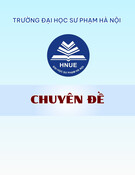
T
ẠP CHÍ KHOA HỌC
TRƯ
ỜNG ĐẠI HỌC SƯ PHẠM TP HỒ CHÍ MINH
Tập 21, Số 6 (2024): 1019-1028
HO CHI MINH CITY UNIVERSITY OF EDUCATION
JOURNAL OF SCIENCE
Vol. 21, No. 6 (2024): 1019-1028
ISSN:
2734-9918
Websit
e: https://journal.hcmue.edu.vn https://doi.org/10.54607/hcmue.js.21.6.4142(2024)
1019
Research Article1
USING CASE STUDY METHOD IN NATIONAL DEFENSE -
SECURITY EDUCATION AT HIGH SCHOOLS IN HO CHI MINH CITY
Le Hoang Phuong*, Nguyen Linh Phong
Ho Chi Minh City University of Education, Vietnam
*Corresponding author: Le Hoang Phuong – Email: hoangphuong291003@gmail.com
Received: February 26, 2024; Revised: March 21, 2024; Accepted: March 25, 2024
ABSTRACT
This study examines the implementation of the case study method in teaching National Defense
- Security Education in Ho Chi Minh City high schools. A survey of 50 teachers and 200 students
from three high schools reveals that while the case study method has been introduced, its application
remains limited, with an average score of 3.19. Students demonstrated a relatively positive attitude
in class, with average scores ranging from 3.26 to 3.69. Interviews with nine teachers of national
defense-security education highlighted challenges associated with the method, including increased
teacher workload, the need for extensive professional experience and practical knowledge in
national defense and security, and the time-intensive nature of student engagement with case studies.
Based on these findings, the article proposes measures to address these limitations and enhance the
effectiveness of the case study method in practice.
Keywords: high school; national defense and security education; case study; teaching methods
1. Introduction
National defense - security education is a part of the national education system, a basic
content in building the national defense, people’s security, is a main subject in the curriculum
from high school to university and political, administrative, and other types of schools.
Therefore, introducing this subject into teaching not only aims to achieve comprehensive
education goals but also creates conditions for the young generation to cultivate qualities,
train abilities, and contribute to educating the future generation of the country with bright
ethics and strong will (Cao & Nguyen, 2018). At the same time, national defense and security
education is also a subject related to strategic issues and tasks of the entire Party, people,
and army, directly contributing to strengthening national defense potential to ensure the
country has enough ability to firmly protect independence, sovereignty, territorial integrity
of the Fatherland (Tran, 2023).
Cite this article as: Le Hoang Phuong, & Nguyen Linh Phong (2024). Using case study method in national
defense - security education at high schools in Ho Chi Minh City. Ho Chi Minh City University of Education
Journal of Science, 21(6), 1019-1028.






























